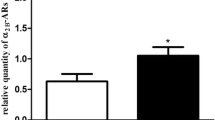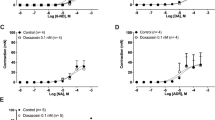Summary
β-Adrenergic receptor stimulation results in smooth muscle relaxation through activation of adenylyl cyclase and subsequent cyclic AMP (cAMP) production. The present study was performed to evaluate the effects of steroid hormones (i.e. testosterone and hydrocortisone) onβ2-adrenergic receptors and their signal transduction in the DDT1 MF-2 genital tract myocyte. Radioligand binding studies demonstrated that these two steroid hormones produced a 70 to 80% increase in the density ofβ2-adrenergic receptors in these myocytes. Stimulation of theβ2-adrenergic receptors with isoproterenol resulted in a significant increase of cAMP in control myocytes; cells treated with testosterone for 24 h demonstrated a comparable response to isoproterenol, whereas hydrocortisone for 24 h resulted in a 50% greater cAMP response. In contrast to the response at 24 h, stimulation of myocytes after testosterone treatment for 48 h resulted in a cAMP response comparable to that seen in response to hydrocortisone at 24 h. Studies performed using theophylline demonstrated similar cAMP responses at 24 h between the control and testosterone-treated myocytes, thereby ruling out the possibility that the delayed increase of the cAMP response after testosterone was caused by stimulation of phosphodiesterase. Direct stimulation with forskolin resulted in greater cAMP production in the testosterone-treated myocytes compared to controls, thereby refuting the possibility that testosterone directly suppresses adenylyl cyclase activity at 24 h. These findings suggest that although both testosterone and hydrocortisone produce a twofold increase inβ2-adrenergic receptor density in the DDT1 myocytes,β2-adrenergic receptors expressed in response to hydrocortisone appear functional at 24 h resulting in increased cAMP production, whereas those expressed in response to testosterone require 48 h to demonstrate increased functional activity.
Similar content being viewed by others
References
Collins, S.; Caron, M. G.; Lefkowitz, R. J.β 2-Adrenergic receptors in hamster smooth muscle cells are transcriptionally regulated by glucocorticoids. J. Biol. Chem. 263:9067–9070; 1988.
Davies, A. O.; Delean, A.; Lefkowitz, R. J. Myocardialβ-adrenergic receptors from adrenalectomized rats: impaired formation of high-affinity agonist-receptor complexes. Endocrinology 108:702–722; 1981.
Davies, A. O.; Lefkowitz, R. J. Corticosteroid-induced differential regulation ofβ-adrenergic receptors in circulating human polymorphonuclear leukocytes and mononuclear leukocytes. J. Clin. Endocrinol. & Metab. 51:599–605; 1980.
Davies, A. O.; Lefkowitz, R. J. Regulation ofβ-adrenergic receptors by steroid hormones. Ann. Rev. Physiol. 46:119–130; 1984.
Fraser, C. M.; Venter, J. C. The synthesis of beta-adrenergic receptors in cultured human lung cells: induction by glucocorticoids. Biochem. Biophys. Res. Comm. 94:390–397; 1980.
Gilman, A. G. Transducers of receptor-generated signals. In: Annual review of biochemistry. Palo Alto, CA: Annual Reviews; 1987:56–71.
Hadlock, J. R.; Malbon, C. C. Regulation ofβ-adrenergic receptors by “permissive” hormones: glucocorticoids increase steady-state levels of receptor mRNA. Proc. Natl. Acad. Sci. USA 85:8415–8419; 1988.
Hatjis, C. G.β-Adrenergic receptor and adenylae cyclase properties in pregnant and nonpregnant guinea pig myometrium. Am. J. Obstet. Gynecol. 151:943–950; 1985.
Lefkowitz, R. J.; Caron, M. G.; Stiles, G. L. Mechanisms of membrane-receptors regulation. Biochemical, physiological and clinical insights derived from studies of the adrenergic receptors. N. Engl. J. Med. 310:1570–1579; 1984.
Mano, K.; Akbarzadeh, A.; Townley, R. G. Effect of hydrocortisone onβ-adrenergic receptors in lung membranes. Life Sci. 25:1925–1930; 1979.
Marone, G.; Lichtenstein, L. M.; Plaut, M. Hydrocortisone and human lymphocytes: increases in cyclic adenosine 3′:5′-monophosphate and potentiation of adenylyl cyclase-activating agents. J. Pharmacol. Exp. Ther. 215:469–478; 1980.
Moawad, A. H.; River, L. P.; Kilpatrick, S. J. The effect of estrogen and progesterone on beta-adrenergic receptor activity in rabbit lung tissue. Am. J. Obstet. Gynecol. 144:608–613; 1982.
Norris, J. S.; Brown, P.; Cohen, J., et al. Glucocorticoid induction ofβ-adrenergic receptors in the DDT1 MF-2 smooth muscle cell line involves synthesis of new receptor. Mol. Cell. Biochem. 74:21–27; 1987.
Norris, J. S.; Garner, D. J.; Brown, F., et al. Characteristics of an adenylate cyclase coupledβ 2-adrenergic receptor in a smooth muscle tumor cell line. J. Recept. Res. 3:623–645; 1983.
Norris, J. S.; Kohler, P. O. The co-existence of androgen and glucocorticoid receptors in the DDT1 cloned cell line. Endocrinology 100:613–618; 1977.
Phillippe, M.; Saunders, T.; Bangalore, S. Alpha-1, alpha-2, andβ-adrenergic signal transduction in cultured uterine myocytes. In Vitro Cell. Dev. Biol. 26:369–378; 1990.
Phillippe, M.; Saunders, T. Testosterone modulation of adrenergic receptor mRNA and protein expression in a genital tract smooth muscle cell line. J. Cell Biol. 111(2):371a; 1990.
Phillippe, M.; Saunders, T.; Bangalore, S. A mechanism for testosterone modulation of alpha-1 adrenergic receptor expression in genital tract smooth muscle myocyte. Mol. Cell. Biochem. 100:79–90; 1991.
Phillippe, M.; Saunders, T.; Harihara, S. Absence of alpha-2 adrenergic effects on cAMP production in a genital tract smooth muscle cell line. Life Sci. 44:1555–1562; 1989.
Reimer, R. K.; Wu, Y. Y. Bottari, S. P., et al. Estrogen reducesβ-adrenoreceptor-mediated cAMP production and the concentration of the guanyl nucleotide-regulatory protein, Gs in rabbit myometrium. Mol. Pharmacol. 33:389–395; 1988.
Roberts, J. M.; Insel, P. A.; Goldfien, A. Regulation of myometrial adrenoreceptors and adrenergic response by sex steroids. Mol. Pharmacol. 20:52–58; 1981.
Roberts, J. M.; Reimer, R. K.; Bottari, S. P., et al. Hormonal regulation myometrial adrenergic responses: the receptor and beyond. J. Dev. Physiol. 11:125–134; 1989.
Scarpace, P. J.; Baresi, L. A.; Sanford, D. A., et al. Desensitization and resensitization ofβ-adrenergic receptors in a smooth muscle cell line. Mol. Pharmacol. 28:495–501; 1985.
Smith, R. G.; Syms, A. J., Norris, J. S. Differential effects of androgens and glucocorticoids on regulation of androgen receptor concentrations and cell growth. J. Steroid Biochem. 20:277–281; 1984.
Strasser, R. H.; Benovic, J. L.; Caron, M. G., et al. Beta-agonist-and prostaglandin E1-induced translocation of the beta-adrenergic receptor kinase: evidence that the kinase may act on multiple adenylyl cyclase-coupled receptors. Proc. Natl. Acad. Sci. USA 83:6362–6366; 1986.
Vallieres, J.; Fortier, M. A.; Bukowiecki, L. Alpha and beta-adrenergic receptors in isolated rabbit uterine membranes: study of receptor alterations by gregnancy. Biol. Reprod. 19:318–325; 1978.
Williams, L. T.; Lefkowitz, R. T. Regulation of rabbit myometrial alpha-adrenergic receptors by estrogen and progesterone. J. Clin. Invest. 60:815–818; 1977.
Author information
Authors and Affiliations
Rights and permissions
About this article
Cite this article
DiGiovanni, L., Austin, R. & Phillippe, M. Steroid hormone modulation of cAMP production in response to beta adrenergic receptor stimulation in genital tract myocytes. In Vitro Cell Dev Biol - Animal 28, 509–514 (1992). https://doi.org/10.1007/BF02634134
Received:
Accepted:
Issue Date:
DOI: https://doi.org/10.1007/BF02634134




